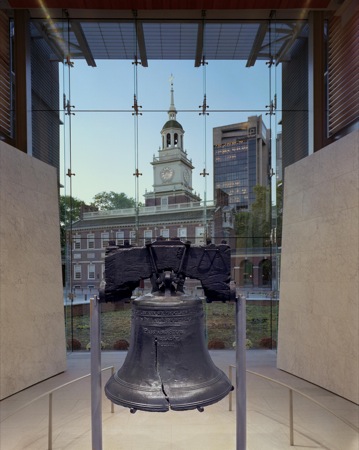
Courtesy National Park Service
President’s House
The newest addition to the park is the President’s House, which was dedicated last December just a few feet from the entrance to the Liberty Bell Center.
“It is an outdoor commemoration of the site where Presidents George Washington and John Adams had a house they lived in while president in Philadelphia,” said Jane Cowley, public affairs officer for the park. “It also tells the story of nine enslaved Africans kept at the house by Washington. It is called ‘Freedom and Slavery in the Making of a New Nation.’
“The house no longer stands; we did not rebuild,” said Cowley. “The site suggests the layout of the house with the footprint marked in pavers on the ground.
“One of the most exciting aspects is there are some architectural fragments that remain. There is a clear glass structure where you can look down and see the remains of the original house.”
Exhibit panels give a brief history of the house and the period in which it stood, and videos show re-enactors talking about what it was like to be a slave in Washington’s household. The names of the nine slaves are engraved on a granite wall at the site.
Across the street, the tower of Independence Hall is undergoing a $4 million renovation, expected to be completed in January.
“The tower was constructed in 1828,” said Cowley. “They are taking out and repairing or replacing the wood exterior. They are trying to preserve as much of the original as they can. When they have to replace wood, it comes from the same area as the original, and they are keeping the same architectural style.”
Cowley said the tower was unusual for its time because it was prefabricated, with layers of wood held together by iron rods, which have rusted.
“A great experience for visitors is there is a mock-up outside where you can see how the wood panels were held together,” she said.
Scaffolding that surrounds the tower is covered with a scrim that has a drawn image of the tower on two sides and a blueprint cutaway on the other two sides “that shows how it looks without walls,” said Cowley.
Independence Hall, which was built in the mid-1700s as the statehouse for the Pennsylvania colony, remains open for tours during the renovation. The hall, where the Declaration of Independence and the Constitution were approved, has been restored to its late-18th-century appearance.
Ben Franklin’s home
Franklin, one of the key members in those deliberations, lived just a few blocks away. An arched brick passageway that leads from Market Street to the site of his former house is the same one he walked through.
No accurate records exist of Franklin’s house, which was torn down after his death. The National Park Service has erected metal outlines of the house and his print shop.
An underground museum at the site is closed until mid-2013 for a major renovation and reconfiguring.
“We are redesigning it for the 21st century,” said Cowley. “It will be more interactive and focus on the various contributions he made over his lifetime.”
The courtyard remains open during the renovation, as do the row houses on Market Street that Franklin built in the 1780s as rental property, which now contain a replica 18th-century printing office and a post office branch.
Independence National Historical Park also oversees the Benjamin Franklin National Memorial, located in the Franklin Institute.
A large seated statue of Franklin sits in the center of the institute’s rotunda; exhibits around the edge of the room deal with Franklin’s career as a printer, a scientist-inventor and a diplomat.
An adjacent science museum has several exhibits about Franklin, and recently added two new permanent exhibits dealing with electricity and the changing earth.
The electricity exhibit has displays of Franklin’s own collection of studies in electricity and demonstrations of how communities can become more energy efficient.
American Jewish history
Although it is not part of the historical park, another new addition to Philadelphia’s history museum scene is the National Museum of American Jewish History, which opened in late November across from Independence Mall and the Liberty Bell Center.
The museum traces the lives of American Jews from 1654 to the present with more than 1,200 artifacts, films and interactive technology spread over three and a half floors. Immersive exhibits include a 1950s living room, a Jewish summer camp and a classroom for immigrants.
Museum officials say it is the only museum in the nation dedicated solely to telling the story of Jews in America.










